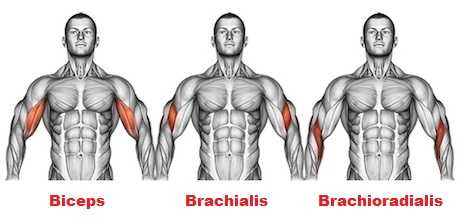Dumbbell Reverse Curl
The dumbbell reverse curl is a simple strength training exercise that involves holding a dumbbell with an overhand grip and curling it towards your shoulder.
Dumbbell reverse curls are a highly effective exercise for building forearm and bicep strength, and can be a valuable addition to any comprehensive arm workout routine. When incorporated correctly, this exercise can help to target and isolate the brachioradialis muscle, which is located in the forearm and contributes to overall grip strength and forearm size.
Many people focus primarily on bicep curls to build bigger arms, but neglect other muscles like the brachioradialis. Incorporating dumbbell reverse curls into your routine can help to balance out your arm development and create a more symmetrical look. Here is an ultimate guide to dumbbell reverse curl:
How To do:
To perform the exercise, follow these steps:
- Stand with your feet shoulder-width apart and hold a pair of dumbbells in front of your thighs, palms facing downward (pronated grip).
- Keep your elbows close to your sides and slowly lift the dumbbells towards your shoulders by flexing your elbows. Keep your wrists straight and your palms facing downwards throughout the movement.
- Pause at the top of the movement and squeeze your forearms and biceps for a second.
- Slowly lower the dumbbells back to the starting position by extending your elbows and maintaining control of the weight.
- Repeat for the desired number of repetitions.
Dumbbell Reverse Curl Benefits
Dumbbell reverse curls are a popular forearm exercise for building forearm strength and size, but many people don’t fully understand how the exercise works. Here’s a breakdown of the science behind dumbbell reverse curls and how they target the forearm muscles:
builds forearm strength and size:
The brachioradialis is a key muscle involved in forearm flexion, which is important for many daily activities like carrying bags, lifting weights, and using tools. Strengthening this muscle with dumbbell reverse curls can improve your overall forearm strength and make it easier to perform these tasks.
How:
Unlike traditional bicep curls, which work primarily the biceps, the dumbbell reverse curl targets the brachioradialis muscle in the forearm. When performing the exercise, the brachioradialis contracts to lift the weight up towards the shoulder, while the biceps and other forearm muscles assist in the movement.
The brachioradialis is particularly well-suited for this exercise because of its location and orientation in the forearm. Because the muscle is located on the outer side of the forearm and runs diagonally across the arm, it is better activated with an overhand grip compared to an underhand grip.
By targeting the brachioradialis muscle, the dumbbell reverse curl can help to improve overall forearm strength and size. Strong forearms are important for a variety of daily activities, including gripping and lifting heavy objects. Additionally, strong forearm muscles can help to improve grip strength and reduce the risk of injury to the wrist and hand.
Balanced arm development:
Many people tend to focus solely on bicep curls to build bigger arms, but neglect other muscles like the brachioradialis, which can result in imbalances and an uneven appearance. One of the other benefits of adding dumbbell reverse curls to your arm workout routine is that it can help stabilize your arm development and create a more symmetrical look.
By adding dumbbell reverse curls to your routine, you can ensure that you are targeting all of the muscles in your arms, including the brachioradialis. This can help to create a more balanced, symmetrical look, and improve overall arm strength and function.
Dumbbell Reverse Curls vs. Regular Biceps Curls
Dumbbell reverse curls and traditional bicep curls are both popular exercises for targeting the biceps, but they differ in terms of the specific muscles they activate and the way they work. Here’s a breakdown of the benefits of each exercise, and when one might be more appropriate than the other:
Dumbbell reverse curls:
- Primary muscle worked: Brachioradialis (forearm muscle)
- Secondary muscles worked: Biceps, brachialis (upper arm muscle)
- Benefits: Targets the forearm muscle and contributes to grip strength, can help to balance out the upper arm muscles, provides a variation to traditional bicep curls
- When to use: If you want to specifically target the forearm muscles or if you feel like your biceps are overpowering your other upper arm muscles.
Traditional bicep curls:
- Primary muscle worked: Biceps brachii (upper arm muscle)
- Secondary muscles worked: Brachialis, brachioradialis (forearm muscle)
- Benefits: Targets the primary muscle of the bicep, allows for heavier weights to be used, provides a classic bicep exercise that can be done with a variety of equipment
- When to use: If you want to focus on building overall bicep size and strength, or if you are limited in equipment and can only do traditional bicep curls.
Ultimately, both exercises have their place in a comprehensive arm workout routine, and the best approach is to incorporate both exercises in a balanced way. For example, you might do dumbbell reverse curls in one workout and traditional bicep curls in the next. It is also possible to combine these two exercises in one workout, you can change this according to your personal goals. By varying your exercises, you can keep your muscles challenged and ensure balanced development over time.
Dumbbell Reverse Curl Muscles Worked



